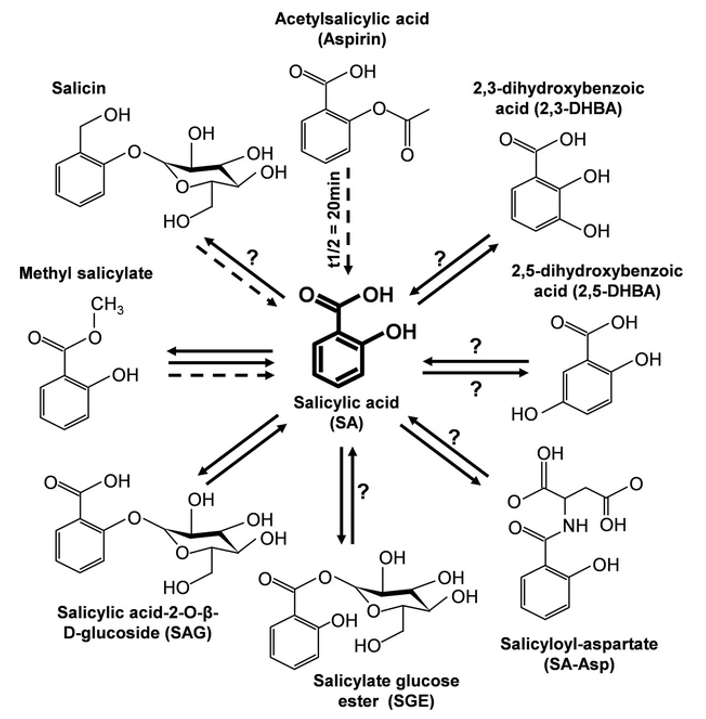v-innovate Technologies offers salicylic acid (SA) analysis service to analyze SA and its derivatives based on state-of-the-art LC-MS/MS platforms in MRM mode, as well as tailored statistical analyses and bioinformatics analyses to meet your project needs. We are committed to putting our clients first, providing excellent and feasible services and achieving the best outcomes we can. Our complete sample-to-data services can help better understand the biosynthesis, function, metabolism, and mechanism of action of SA.
Plants have developed complex mechanisms to protect themselves from pathogen attacks and other environmental stresses. In recent years, salicylic acid (SA; 2-hydroxybenzoic acid) has emerged as an important plant hormone with key roles in the defense against biotrophic pathogens. Studies have identified SA receptor proteins and revealed the regulation of pathogen-induced SA biosynthesis and how SA regulates defense gene expression. SA is required for the expression of many defense genes and the assembly of root microbiome. Methyl salicylate (MeSA), a derivative of SA, acts as a long-distance mobile signal for inducing systemic acquired resistance (SAR) in uninfected parts of plants. SA is methylated by SA carboxyl methyltransferase (SAMT) to form MESA, which travels to the systemic tissues and activates resistance following its conversion back SA by SA-binding protein 2 (SABP2). Liquid chromatography-tandem mass spectrometry (LC-MS/MS) is generally used for the detection of SA. v-innovate Technologies has developed an accurate and feasible protocol for the quantitative determination of salicylic acid in given plant tissues. Multiple reaction monitoring (MRM) is utilized for data acquisition, which is a highly specific and sensitive label-free technique for detecting and quantifying selected protein/peptides of interest.
 Figure 1. SA undergoes many modifications in plants (Dempsey & Klessig 2017).
Figure 1. SA undergoes many modifications in plants (Dempsey & Klessig 2017).
Our newly developed sample preprocessing method provides safety, environmental protection, rapidness, effectiveness, and recovery rates consistently exceeding 85%. Sample preprocessing at v-innovate Technologies complies with in-house standard operation procedures (SOPs), ensuring maximized homogeneity between samples. Electrospray ionization (ESI) is performed with a triple quadrupole LC/MS system, and MRM is utilized for data acquisition.

Quantification methods: external reference method or isotope-labeled internal standard method
Mode: MRM, capable of simultaneously detecting more than 1000 MRM ion pairs
Precision: ≤10-9 g
Positive/Negative polarity switching time: ≤20 ms, allowing for the acquisition of Q1/Q3 MRM transition mass spectra in both ionization modes from a single LC-MS/MS run.
| Detectable SAs | CAS | Quantification Methods |
|---|---|---|
| SA | 69-72-7 | External reference method / isotope-labeled internal standard method |
| MESA | 119-36-8 | External reference method / isotope-labeled internal standard method |
1. Fresh plant tissues from leaf, flower, stem, root, or fruit: >2 g. Provide young plant tissues for best results. Samples should be frozen in liquid nitrogen immediately after collection, and then transferred to -80°C for storage.
2. Plant seeds: >2 g.
At least 3 biological replicates.
v-innovate Technologies provides plant hormones analysis services to determine the level of specific hormones in plant tissues powered by state-of-the-art mass spectrometry coupled with gas chromatography (GC) or liquid chromatography (LC), which is essential for revealing the roles and functions of various phytohormones in plant growth, development, and resistance. Please do not hesitate to contact us for detailed information about our SA and MESA analysis services.
References
